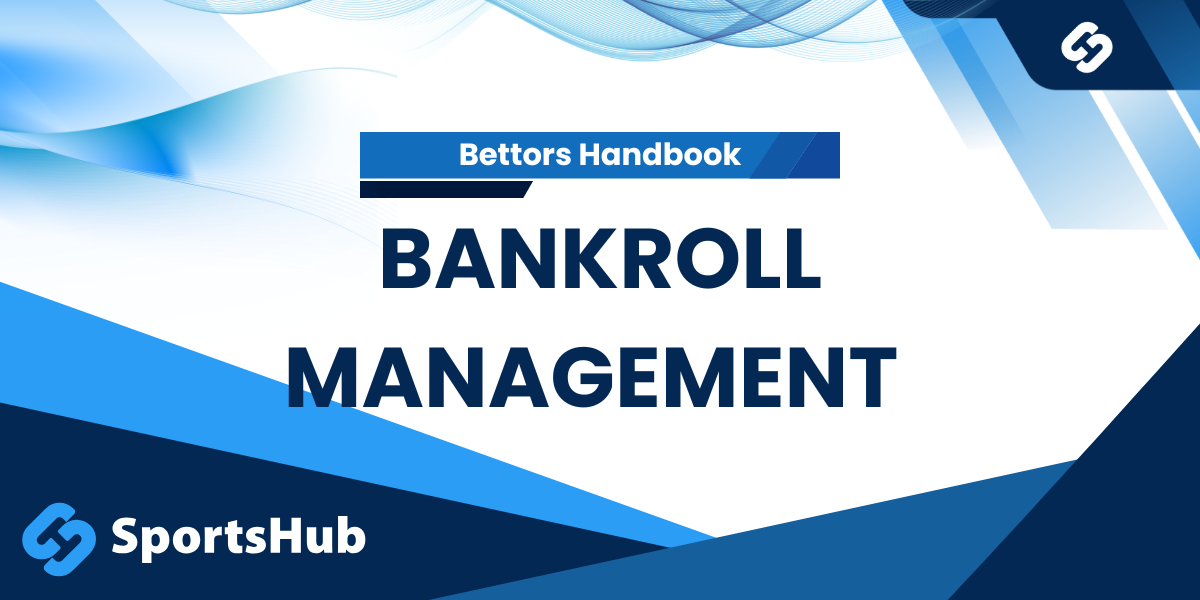Effective Bankroll Management for Sports Bettors
Bankroll management for sports betting is essential for bettors who want to maximize long-term profitability. Effective bankroll management involves setting rules for how much to wager on each bet.

What is a Bankroll?
In the context of sports betting, a bankroll refers to the total amount of money that an individual has set aside exclusively for placing bets. This isn’t just any discretionary fund; it is a predefined sum that a bettor dedicates to wagering activities, separate from personal savings, emergency funds, and daily living expenses.
Determining Your Bankroll Size
Setting aside a specific amount of money dedicated solely to betting requires careful consideration of one’s financial situation. Here is a guide to help you determine the appropriate size for your bankroll:
Assess Your Financial Health
Before deciding on a bankroll size, take a thorough look at your financial situation. Ensure that all your essential needs, such as rent, utilities, groceries, savings, and any debts, are accounted for. The money you allocate as your bankroll should be surplus to these essential expenses, meaning you can afford to lose it without affecting your daily life.
Set Realistic Goals
Consider what you aim to achieve through betting. Are you betting for fun, or do you intend to make a serious attempt at generating a consistent profit? Your goals can influence the size of your bankroll. For recreational bettors, a smaller bankroll might suffice, while more serious bettors might opt for a larger one to employ various betting strategies.
Decide on a Comfortable Amount
The key is to ensure that the money you set aside does not put you at financial risk or cause stress. A general recommendation for beginners is to start with a bankroll that represents a small percentage of their disposable income, such as 1-5%.
Consider the Betting Unit
Once you’ve established your total bankroll, you can define a betting unit, which is a fixed percentage of your bankroll that you’re comfortable wagering on a single bet. This helps in spreading out the risk.
Be Prepared to Adjust
Your financial situation and betting performance will evolve over time. Be prepared to re-evaluate and adjust your bankroll size accordingly. If you experience success and your bankroll grows, you may decide to increase your betting unit size. Conversely, during tough times, consider reducing it to protect your bankroll.
Basic Principles of Bankroll Management

Effective bankroll management is essential for anyone looking to engage in sports betting seriously or even casually with a disciplined approach. Understanding and applying the basic principles of bankroll management can significantly enhance the betting experience, making it more enjoyable and sustainable. Here are the foundational principles:
Separation of Funds
The cornerstone of sound bankroll management is the strict separation of betting funds from personal finances. This principle ensures that the money allocated for betting activities does not overlap with funds needed for essential expenses, savings, or emergency purposes.
By maintaining a clear boundary, bettors can protect their financial well-being and avoid the potential stress and financial difficulties that can arise from using personal funds for betting. This separation requires a more objective and analytical approach to betting, free from the pressures of impacting one’s financial security.
Understanding Risk
Sports betting, by its nature, involves a significant degree of risk. Every wager carries the potential for loss, regardless of the perceived certainty of the outcome.
Recognizing and accepting the inherent risks is crucial for developing a risk management strategy that includes setting limits on bets in proportion to the bankroll and avoiding the temptation to chase losses with increasingly larger bets. A well-considered approach to risk can help in minimizing losses and preserving the bankroll over the long term, allowing for more opportunities to bet and potentially profit.
The Psychological Aspect
Bankroll management is not just a financial strategy; it also involves significant emotional discipline. The ability to stick to a predetermined plan in the face of losses or wins requires a strong mindset. Human nature often drives us towards impulsive decisions, especially after a losing streak (chasing losses) or a winning streak (overconfidence leading to larger bets).
The discipline required to adhere to bankroll management principles helps in mitigating these psychological pitfalls. It ensures that betting decisions are based on logic and strategy rather than emotion, thereby enhancing the potential for success.
Bankroll Management Strategies
Here are a few bankroll management strategies for sports betting that you may want to consider using.
Fixed Unit Betting
Fixed unit betting is a straightforward and disciplined approach where the bettor wagers the same fixed amount, or “unit,” on every bet, regardless of the confidence level or the odds. This method simplifies decision-making and helps maintain consistent betting practices.
The size of the unit is typically a small, fixed percentage of the initial bankroll, often ranging between 1% and 5%. The primary advantage of this method is its simplicity and the protection it offers against significant losses during a losing streak. It allows bettors to manage their bankroll effectively over the long term without the need to adjust bet sizes based on the perceived value of each wager.
Percentage of Bankroll
The percentage of bankroll method involves betting a specific percentage of your current bankroll on each wager, allowing the bet size to fluctuate based on the size of your bankroll. For example, if a bettor decides on a 2% bet size and has a $1,000 bankroll, they would bet $20 on a single wager. If the bankroll increases to $1,200, the bet size adjusts to $24 per wager.
Conversely, if the bankroll decreases, the bet size shrinks accordingly. This method ensures that bet sizes are always proportionate to the current bankroll, promoting a more dynamic betting strategy that can potentially maximize earnings during winning streaks and minimize losses during downturns.
Confidence Level Betting
Confidence level betting offers a more variable approach, where bet sizes are adjusted based on the bettor’s confidence in the outcome of a wager. This method requires the bettor to assign a confidence level to each bet, typically on a scale (for example, from 1 to 10), and wager a proportionate amount of their bankroll accordingly.
Higher confidence levels justify larger bets, while lower confidence wagers receive smaller bets. This strategy demands a good understanding of the events being bet on and an ability to accurately gauge confidence levels. While potentially more profitable, it also introduces more risk if the bettor’s confidence assessments are not accurate.
Kelly Criterion
The Kelly Criterion is a mathematical formula designed to optimize bankroll growth by determining the optimal bet size based on the perceived value and odds of a bet. The formula is:
Bet size = (bp-q)
b
- b is the decimal odds of the wager (minus 1),
- p is the probability of winning,
- q is the probability of losing (which is 1 – p),
- bp−q represents the perceived edge or value of the bet.
The Kelly Criterion recommends betting a fraction of the bankroll proportional to the edge over the bookmaker. If the calculated bet size is positive, it suggests an edge exists, and the bet is worth making. Conversely, a negative result indicates no edge, suggesting the bettor should avoid the wager.
Adjusting Your Bankroll Management Plan

Reassessing Your Bankroll
The need to reassess your bankroll arises naturally over the course of betting due to the fluctuations inherent in winning and losing. It’s advisable to set regular intervals for reassessment, such as monthly or quarterly, to review your betting performance and adjust the size of your bankroll and betting strategy as necessary. Here are key points to consider when reassessing your bankroll:
Performance Evaluation
Analyze your betting performance over the reassessment period. Determine whether you’re ahead, breaking even, or behind. Consider the impact of your betting strategy on these outcomes.
Adjustment Based on Performance
If you’ve experienced significant losses, it may be wise to reduce your bankroll to reflect your current financial situation and minimize future risks. Conversely, if you’ve been successful, you might decide to increase your bankroll to leverage your winning strategy, though this should be done cautiously to avoid overextension.
Reflect on Betting Strategy
Reassess the effectiveness of your betting strategy. Winning streaks don’t necessarily validate a strategy, just as losing streaks don’t always discredit it. Consider the role of variance and luck. Adjust your strategy if you identify better approaches or if your current method isn’t yielding the expected results.
Lifestyle and Financial Changes
Your bankroll isn’t just about wins and losses; it’s also about your personal financial situation. If your income, expenses, or financial goals have changed, adjust your bankroll accordingly to ensure it remains a responsible portion of your discretionary funds.
Dealing with Winning and Losing Streaks
Winning Streaks:
- Avoid Overconfidence: It’s easy to become overconfident during a winning streak and start betting outside your established parameters. Stick to your bankroll management strategy to avoid giving back your winnings.
- Consider Banking Profits: During extended winning streaks, consider banking a portion of your profits to secure gains, ensuring that you have something to show for your successful run.
Losing Streaks:
- Stay Disciplined: The most important advice during a losing streak is to remain disciplined. Do not chase losses by increasing your bet sizes or making more risky bets in an attempt to recover funds quickly.
- Review Your Strategy: Use losing streaks as an opportunity to review your betting decisions and strategy. Assess whether bad luck, poor judgment, or a combination of both contributed to your losses.
- Adjust Your Bankroll: If necessary, adjust your bankroll to reflect your current situation. Reducing your bet sizes can help you weather the storm without exhausting your funds.
Common Bankroll Management Mistakes

Overbetting
Overbetting occurs when a bettor wagers too large a portion of their bankroll on a single event, significantly exceeding the size recommended by their bankroll management strategy. This practice is risky because it exposes the bettor to the possibility of substantial losses from just one or a few bets, potentially jeopardizing their entire bankroll and their ability to continue betting.
The allure of a high payout can be tempting, but the risk of a major setback often outweighs the potential rewards. It’s essential to resist the temptation to overbet and instead adhere to predetermined betting sizes that align with a well-thought-out bankroll management plan. This disciplined approach helps ensure that bettors can weather losing bets and remain active in the long term.
Chasing Losses
Chasing losses is a dangerous practice where bettors increase their bet sizes or the frequency of their bets in an attempt to recover previous losses quickly. This behavior is often driven by frustration, impatience, or the flawed belief that a winning bet is due after a string of losses.
However, chasing losses can lead to even greater financial harm, as it usually involves making poorly considered bets with increasingly significant portions of the bankroll, further exacerbating the situation. The key to avoiding the trap of chasing losses is to maintain discipline, stick to your bankroll management strategy, and accept that losses are a part of sports betting. Patience and a long-term perspective are crucial for successful betting.
Ignoring Bankroll Management
Neglecting bankroll management and betting without a disciplined strategy can have severe long-term consequences for bettors. Without a system to manage their funds, bettors are more likely to make impulsive decisions, overbet, chase losses, and ultimately risk their entire bankroll on high-stake wagers with poor value.
This approach not only increases the likelihood of significant financial losses but can also lead to stress, frustration, and a negative impact on personal finances and well-being.
Conclusion
Bankroll management is the cornerstone of successful and sustainable sports betting, enabling bettors to navigate the inherent volatility and risks with discipline and control. By adhering to strategies that dictate how much to bet, when to bet, and when to step back, bettors can prolong their betting endeavors, making the activity both enjoyable and potentially profitable in the long term.
